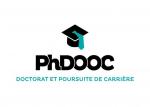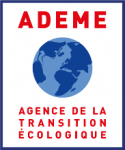COFUND PhD position - Zoology / Behavioural biology
| ABG-133795 | Sujet de Thèse | |
| 13/10/2025 | Financement de l'Union européenne |

- Biologie
Description du sujet
Title of the thesis project: Mechanisms of wild seal movements – a computational approach (SealMove)
Scientific description of the research project
Harbour seals (Phoca vitulina) are semi-aquatic animals that divide their time between land and sea.
While on land, the seals primarily rest at specific sites known as haulout places; although female seals also nurse their pups during a 4-6-week period in (late) summer at these haulout places (Harvey, Chudzinska et al. 2022). After resting, the seals return to the water in search for food or potential mates. The seals’ movement behaviour e.g. at sea has been described in detail by wildlife researchers (such as the La Rochelle supervisor Cécile Vincent) using tagging technology on wild seals (see e.g. an exemplary data set published by Vincent 2020 on https://www.seanoe.org/data/00785/89715). The tagging data reveal that the seals’ foraging trips are highly individual: some remain close to shore and spend only a few hours at sea, whereas others travel far offshore and may stay away from shore for several days (e.g. Thompson, Mackay et al. 1998, Vance, Hooker et al. 2021). Regardless of the distance or the duration of their trips, most harbour seals return to one of their few haulout places afterward (e.g. Vincent 2020).
The seals’ movement behaviour suggest that seals rely on sophisticated orientation and navigation mechanisms. However, while their movements have been well documented, the underlying mechanisms remain largely speculative. Researchers (such as the Rostock supervisor Frederike Hanke) working with captive seals aim to uncover the sensory abilities of seals that may aid in orientation and navigation (for review see Hanke and Reichmuth 2022). Moreover, lab experiments specifically targeting mechanisms of orientation and navigation were/are conducted such as those investigating goal localization with landmarks (Maaß and Hanke 2022, Maaß, Pfuhl et al. 2022).
In the proposed PhD project, wild harbour seal movements will be analysed regarding putative underlying mechanisms in an approach combining statistical data analysis and mathematical modelling. The project will mainly target orientation/navigation mechanisms directly integrating tagging data obtained from wild seals with evidence derived from or worked on in parallel in lab experiments in Rostock.
To give two examples, a modelling approach can determine whether there is evidence for orientation/navigation with landmarks or path integration. Any object that can be clearly distinguished from background can serve as landmark, meaning as a point of reference (for review see Yesiltepe, Conroy Dalton et al. 2021). While Matsumura et al. (2011) had speculated about elephant seals using landmarks, Maaß and colleagues (Maaß and Hanke 2022, Maaß, Pfuhl et al. 2022) showed that harbour seals can use landmarks to localize goals in lab experiments; the captive seals primarily encoded vector information to localize the goals relative to the landmarks. In the seals’ habitat, natural as well as anthropogenic structures could serve as landmarks to be used for goal localization or for orientation/navigation. This PhD project will aim at correlating wild seal movements with the GPS locations of objects possibly serving as landmarks. One hypothesis to investigate is that landmarks serve as decision points during wayfinding (Yesiltepe, Conroy Dalton et al. 2021) at which seals might show a clear change in movement behaviour. Challenges associated with this project will be to formulate testable hypotheses – even beyond the one just mentioned, to identify and map putative landmarks – if possible, even in water – or to define criteria for behavioural changes.
Path integration, sometimes also called dead reckoning or vector navigation (Darwin 1873, Wehner 1982,
Gallistel 1990), refers to a navigational mechanism during which an animal keeps track of all distances covered and angles steered during the outbound path. It then integrates all this information to obtain a homing vector which will lead it back to e.g. the starting point of its journey. The best- described animal model for path integration is the desert ant (for book review see Wehner 2021). In marine mammals, Fuiman et al (2020) had speculated about and analysed Weddell seal tracks regarding path integration. In general, path integration is an interesting mechanism to look at in e.g. harbour seals as it would be informative for their homing behaviour in the presence and absence of external sensory cues; path integration can even be performed based on self-motion cues alone. The latter might particularly be interesting for animals inhabiting environments in which external cues might be sparse such as e.g. the open ocean. This PhD project will aim at modelling wild seal movements on the basis of path integration models. We would mainly focus on the Müller and Wehner model (Müller and Wehner 1988), but might additionally consult alternative path integration models (Jander 1957, Mittelstaedt and Mittelstaedt 1982, Benhamou, Sauvé et al. 1990) to assess whether the movement behaviour shown during loop trips, defined as trips starting and ending at the same haulout site, will show characteristics indicating underlying path integration abilities. Challenges associated with the path integration analysis will be how to define outbound and inbound path or how to define regular steps – horizontally or even vertically (considering the dives) – with raw data that is irregular in the temporal and spatial domain; this irregularity is caused by the GPS tag only transmitting data when the seal is at the surface.
Moreover, evidence for path integration such as a high degree of straightness of the inbound path has to be disentangled from alternative mechanisms that would also result in straight inbound paths such as wayfinding with landmarks.
Additional analyses can aim at analysing (1) whether wild seal movements – or segments of the trips – can be described as random movements, thereby deviating from classic thoughts of seal movements being guided by either external or internal sensory cues (e.g. Hanke and Reichmuth 2022), (2) whether wild seal movements correlate with oceanographic parameters (e.g. Chevaillier et al., 2014) or (3) how the movement patterns of wild harbour seals deviate from those of grey seals (Halichoerus grypus).
Besides the mentioned fields of research, we want to allow and encourage the PhD student to develop own ideas to work on fostering the PhD student’s independence and intrinsic motivation. The project will benefit from the decades-long experience of Dr. Vincent and Prof. Dr. Hanke working on wild and captive seals, respectively, and the availability of data from over two hundred of tagged seals, provided over 1.2 millions of GPS locations over the last two decades.
Prise de fonction :
Nature du financement
Précisions sur le financement
Présentation établissement et labo d'accueil
Since its creation in 1993, La Rochelle Université has been on a path of differentiation.
Thirty years later, as the university landscape recomposes itself, it continues to assert an original proposition, based on a strong identity and bold projects, in a human-scale establishment located in an exceptional setting.
Anchored in a region with highly distinctive coastal features, La Rochelle Université has turned this singularity into a veritable signature, in the service of a new model. Its research it addresses
the societal challenges related to Smart Urban Coastal Sustainability (SmUCS).
The new recruit will join the Pelagis Observatory.
Cotuelle: University of Rostock (UROS), Germany. Faculty for Mathematics and Natural Sciences, Institute for Biosciences, Neuroethology.
Etablissement délivrant le doctorat
Profil du candidat
We seek an MSc student (Master in the field of Natural Sciences, Mathematics, or Informatics) with strong background in statistical data analysis and related computational methods. The applicant has to be proficient in using data analysis software packages like R, or similar, and has to have profound skills in programming in Python, C++ or a similar programming language. Preferably, the applicant has already analysed/worked with large GPS data sets. The candidate should also be proficient in scientific literature searching and reading, and scientific writing in English. The PhD candidate is expected to work with different partners located in different countries and should demonstrate good communication skills in English and willingness to work in an international team.
Vous avez déjà un compte ?
Nouvel utilisateur ?
Vous souhaitez recevoir nos infolettres ?
Découvrez nos adhérents
 ANRT
ANRT  MabDesign
MabDesign  SUEZ
SUEZ  PhDOOC
PhDOOC  ASNR - Autorité de sûreté nucléaire et de radioprotection - Siège
ASNR - Autorité de sûreté nucléaire et de radioprotection - Siège  Tecknowmetrix
Tecknowmetrix  Nokia Bell Labs France
Nokia Bell Labs France  Laboratoire National de Métrologie et d'Essais - LNE
Laboratoire National de Métrologie et d'Essais - LNE  Ifremer
Ifremer  ONERA - The French Aerospace Lab
ONERA - The French Aerospace Lab  Aérocentre, Pôle d'excellence régional
Aérocentre, Pôle d'excellence régional  MabDesign
MabDesign  CESI
CESI  CASDEN
CASDEN  Institut Sup'biotech de Paris
Institut Sup'biotech de Paris  Généthon
Généthon  ADEME
ADEME  TotalEnergies
TotalEnergies  Groupe AFNOR - Association française de normalisation
Groupe AFNOR - Association française de normalisation



